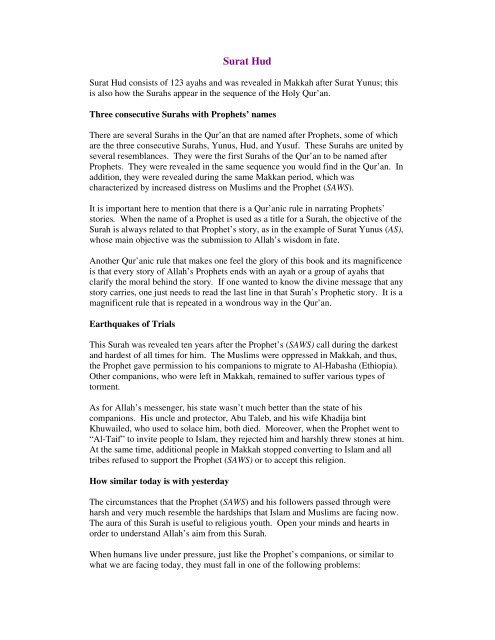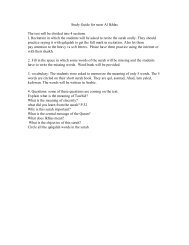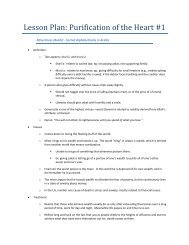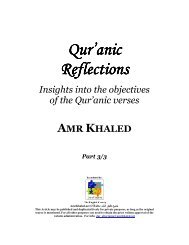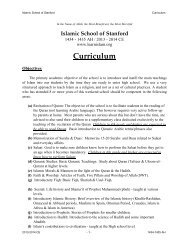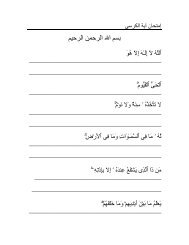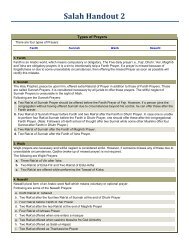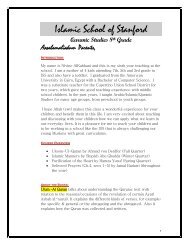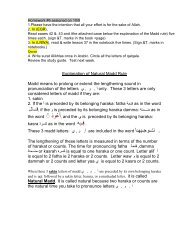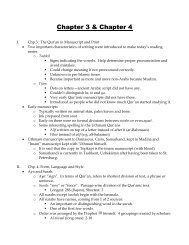Quranic Reflections - Islamic School of Stanford
Quranic Reflections - Islamic School of Stanford
Quranic Reflections - Islamic School of Stanford
Create successful ePaper yourself
Turn your PDF publications into a flip-book with our unique Google optimized e-Paper software.
Surat Hud<br />
Surat Hud consists <strong>of</strong> 123 ayahs and was revealed in Makkah after Surat Yunus; this<br />
is also how the Surahs appear in the sequence <strong>of</strong> the Holy Qur’an.<br />
Three consecutive Surahs with Prophets’ names<br />
There are several Surahs in the Qur’an that are named after Prophets, some <strong>of</strong> which<br />
are the three consecutive Surahs, Yunus, Hud, and Yusuf. These Surahs are united by<br />
several resemblances. They were the first Surahs <strong>of</strong> the Qur’an to be named after<br />
Prophets. They were revealed in the same sequence you would find in the Qur’an. In<br />
addition, they were revealed during the same Makkan period, which was<br />
characterized by increased distress on Muslims and the Prophet (SAWS).<br />
It is important here to mention that there is a Qur’anic rule in narrating Prophets’<br />
stories. When the name <strong>of</strong> a Prophet is used as a title for a Surah, the objective <strong>of</strong> the<br />
Surah is always related to that Prophet’s story, as in the example <strong>of</strong> Surat Yunus (AS),<br />
whose main objective was the submission to Allah’s wisdom in fate.<br />
Another Qur’anic rule that makes one feel the glory <strong>of</strong> this book and its magnificence<br />
is that every story <strong>of</strong> Allah’s Prophets ends with an ayah or a group <strong>of</strong> ayahs that<br />
clarify the moral behind the story. If one wanted to know the divine message that any<br />
story carries, one just needs to read the last line in that Surah’s Prophetic story. It is a<br />
magnificent rule that is repeated in a wondrous way in the Qur’an.<br />
Earthquakes <strong>of</strong> Trials<br />
This Surah was revealed ten years after the Prophet’s (SAWS) call during the darkest<br />
and hardest <strong>of</strong> all times for him. The Muslims were oppressed in Makkah, and thus,<br />
the Prophet gave permission to his companions to migrate to Al-Habasha (Ethiopia).<br />
Other companions, who were left in Makkah, remained to suffer various types <strong>of</strong><br />
torment.<br />
As for Allah’s messenger, his state wasn’t much better than the state <strong>of</strong> his<br />
companions. His uncle and protector, Abu Taleb, and his wife Khadija bint<br />
Khuwailed, who used to solace him, both died. Moreover, when the Prophet went to<br />
“Al-Taif” to invite people to Islam, they rejected him and harshly threw stones at him.<br />
At the same time, additional people in Makkah stopped converting to Islam and all<br />
tribes refused to support the Prophet (SAWS) or to accept this religion.<br />
How similar today is with yesterday<br />
The circumstances that the Prophet (SAWS) and his followers passed through were<br />
harsh and very much resemble the hardships that Islam and Muslims are facing now.<br />
The aura <strong>of</strong> this Surah is useful to religious youth. Open your minds and hearts in<br />
order to understand Allah’s aim from this Surah.<br />
When humans live under pressure, just like the Prophet’s companions, or similar to<br />
what we are facing today, they must fall in one <strong>of</strong> the following problems:


